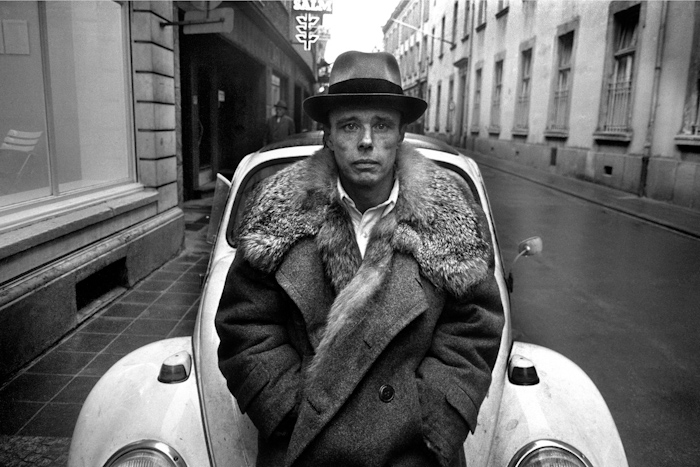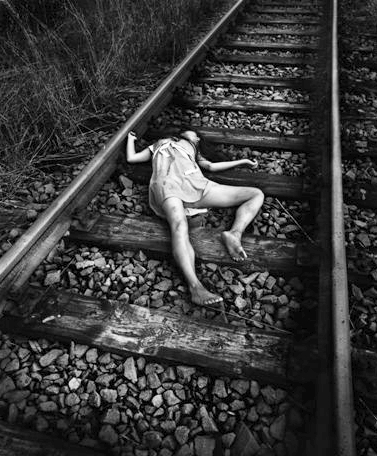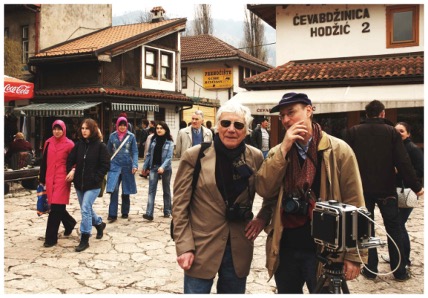Salvador Dalí and Philippe Halsman: 37 Years of Collaboration
Salvador Dalí and Philippe Halsman’s 37-year collaboration challenged viewers and revealed connections between the traditionally realistic medium...
Theodore Carter 24 October 2025
Tadeusz Rolke, hailed as an icon and legend of Polish photojournalism, died in his native Warsaw in July 2025, at the age of 96. He dedicated his entire life to photography. He brought together Poles, Germans, and Ukrainians—neighboring citizens with complicated historical relationships—and fostered a photographic community rooted in his Renaissance-inspired ideal of humanism. This review is an homage to my mentor.

Tadeusz Rolke, Lucy, Warsaw, 1967. FotoTapeta.
Tadeusz Rolke’s photographic vision was multifaceted, with topics ranging from post-World War II Warsaw to fashion and nude photography. He created a rich collection of artists’ portraits and initiated various projects remembering the atrocities in Polish history.
I was personally involved in his endeavor to define the ethical values of today’s photojournalism amid the introduction of digital cameras. Rolke never embraced digital photography but rather stuck to using film his entire life, thus producing an impressive archive of tens of thousands of negatives and thousands of slides. This fashion photograph from the 1950s introduces one facet of his work, showing his carefree style and open character.

Tadeusz Rolke, Cover photograph for Stolica, 1958, Museum of Modern Art in Warsaw, Warsaw, Poland.
During the Warsaw Uprising, which began in the summer of 1944, Rolke was 15 years old. Like many boy scouts, he had participated in the revolt against the German occupiers. In September, he was deported to Germany and forced to work on a farm south of Berlin. Later, he was sent back to Poland to dig trenches against the advancing Soviet forces.
After studying art history, Rolke began his career as a photographer in Warsaw in the mid-1950s. He worked for the famous Stolica (The Capital) magazine, creating small photographic essays about the city. Here, Rolke captured the fun of boys playing during the harsh Warsaw winters.

Tadeusz Rolke, Cover photograph for Stolica, 1958, Museum of Modern Art in Warsaw, Warsaw, Poland.
Rolke loved wandering through the streets of postwar Warsaw with his little Zorka camera, capturing the small joys of everyday life. At night, without a flash, he pushed his films to 800 ASA. To him, a camera was good if it was small and easy to handle—the less you noticed it, the better. With his love for life and eagerness to connect with all kinds of people—famous or not—he captured lively, vibrant images. “Ethics, then esthetics,” he told me in a 2008 interview. This is a photograph of Warsaw’s famous Nowy Świat, or “New World Street,” a scene recognizable even today.
Many street photographers today (unfortunately, I might add) are working in a “Cartier-Bresson mode,” that is, they look for “the decisive moment” that does not illustrate anything. I describe this approach as trying to show a “capricious moment between time.” This was not Rolke’s approach or intent. His photographs are now an essential record of Warsaw’s postwar history. After his funeral mass, a letter from the Mayor of Warsaw was read aloud, thanking Rolke for his contribution to the documentation of the slow recovery of a severely damaged city—85% of Warsaw was deliberately and systematically demolished by German troops as retaliation for the Warsaw Uprising.

Tadeusz Rolke, Joseph Beuys, Düsseldorf, 1971, Museum of Modern Art in Warsaw, Warsaw, Poland.
Rolke spent the 1970s in Hamburg, Germany, where he perfected his German and deepened his fascination with art. Poland, Germany, and later Ukraine, became his major photographic interests and he built a rich archive of artists’ portraits. This iconic photograph shows Joseph Beuys, a much-discussed and controversial figure in German art of the 1970s.
People often praise photographers by saying, “You are a great artist.” Rolke and I discussed this many times and he never considered himself an artist, but always a photographer. A great photographer is one who respects people and treasures life as it is—the best and worse—and who tries to document situations or his or her relationship to a situation.

Tadeusz Rolke and Chris Niedenthal from the exhibition Sąsiadka (My Neighbor) at Zachęta Gallery, 2001, Warsaw, Poland. fotopolis.
On special projects, Rolke worked with other photographers. I admire his approach to collaboration: the individual photographer must not give up his or her individuality within a joint project. The 2001 exhibition Sąsiadka (My Neighbor) in Warsaw’s Zachęta Gallery was a milestone in Rolke’s career. Together with Chris Niedenthal—famous his images of Poland before and after the 1981 declaration of martial law—Rolke documented Jedwabne in northeastern Poland. It is a small town that has become synonymous with the atrocities against the Jewish population.
In July 1941, Polish men, with German troops standing by, forced the town’s Jews into a barn, which they then set on fire. Rolke photographed his young Vietnamese neighbor Maja in Jedwabne, symbolizing all of today’s outsiders in a hostile world. Though never a political activist, Rolke was committed to humanist ideals in his photography.

Tadeusz Rolke, Bakery in Chodovici, Ukraine for the Bread (Chleb) project, 2007. fototapetaart.
A few years after the famous My Neighbor exhibition, I had the privilege to work with Rolke. He had approached me with the idea of producing a sort of manifesto concerning the principles of documentary photography. We invited Chris Niedenthal, Maciej Skawiński, and Armand Urbaniak to photograph bakers in Ukraine, Poland, the Czech Republic, Germany, and France. On this symbolic voyage from Eastern to Western Europe, we showed that bread is the common denominator of European culture, transcending all other political and national differences.
Rolke was an assignment photographer and excelled when he had a specific task. I believe that photographers produce their best work when photographing within a strict framework because it enables them to condense the meaning of their pictures, enforcing a much more direct reception, thus creating resonance in the viewer’s imagination.

Tadeusz Rolke, Zacisze, Warsaw, 2010. Singer Festival.
If Rolke was at his best when he had a specific assignment, then perhaps his greatest single photograph is this one, which he called Zacisze after a neighborhood in central Warsaw. It was part of a one-man, one-photograph exhibition during the 2010 Warsaw Singer Festival dedicated to the memory of Warsaw Jews.

Tadeusz Rolke at 13 years old, 1942, exhibition view at the Singer Festival, 2010, Warsaw, Poland.
Rolke shows a girl posing dead on a railway track, recreating an image that had haunted him since he was 13. On a hot August day in 1942, a woman threw herself onto the tracks from a train heading toward a concentration camp. Rolke, the photojournalist, tried to photograph what can no longer be photographed, but must be remembered. This was Rolke at his most powerful. He included a statement, and a childhood picture of himself, alongside the huge black and white print. Remembering what he saw as a boy he wrote:
It is 1942. Hot August. As usual, I am spending my vacation at my uncle’s Salinger place, in Zacisze. The village is located near the train line Warsaw-Vilna. Every day I watch trains passing by. Among them are also those running from the Warsaw ghetto to Treblinka. This morning I saw three local men. They were bending down upon the trackway. I came closer and saw a still young woman, dead. She was lying barefoot. Her face was covered with hair. She died by jumping from the running train. Men took her by the hands and legs and carried her away. They dug a grave and buried her. I know that I will never forget this place. I am 13 years old and my name is Tadeusz Rolke.
Singer Festival, 2010.

Tadeusz Rolke, Podhajce, Ukraine, 2003 for We Were Here (Tu byliśmy). Newsweek.
“I’ve long been interested in Jewish history,” Rolke wrote. “As a photographer, I felt I had to make it my subject. In 1990, on my way back to Lviv, I spent a few hours in Przemyśl. I went to a bookstore and bought a copy of Martin Buber’s Hasidic Stories. This instructive book was the reason why, three years later, I was in the town of Bełz and took my first photographs. I search for these places, avoiding modern-day television antennas, advertisements, and parked cars.”

Tadeusz Rolke, Untitled, Zielona Góra, 1960 from A Woman Is… album, 2008. poczytaj.pl.
Rolke loved women, and women loved him. His book, a small album called Kobieta to… (A Woman is…), was published in 2008 with a poetic essay by Andrzej Poniedzielski and art direction by Izabela Wojciechowska. In this album, we see women of all ages and all stages of life. Rolke presents them without names, dates, or places, offering a timeless view of women. “I prefer women to politics,” he once stated ironically.

Cover of Tadeusz Rolke. My Passion, 2016.
Not unlike a rock star, Rolke loved to perpetuate a “bad boy” image, dressing in dark clothes and wearing dark sunglasses, even on the coldest and darkest Warsaw winter days. His smile could be very mischievous, and very attracting. In 2016, he published a book titled Moja namiętność (My Passion).
However, the Polish word namiętność means more than just passion; it is the striving for the fulfillment of one’s desires—a driving, ardent affection for, a devotion to—in his case, women. Beneath his composed appearance, Rolke was intensely passionate about life and relationships. This cover photograph perhaps reveals how he truly felt and clearly saw himself.

Jakub Ismer, Tadeusz Rolke and Lorne Liesenfeld, Sarajevo, 2007. Author’s archive.
As a young, unknown photographer striving to build a reputation in Warsaw, I was fortunate to call Rolke, 30 years my senior, my mentor. We worked together on the Bread project from 2004 to 2007, then Rolke embarked on new projects, forming new groups with other people. He was always on the move, integrating others into his greater picture of the world, yet leaving space for individual thought and action. He was always on the go. On the day Rolke died, his suitcase was already packed—ready for a short vacation to the countryside.
Author’s bio:
Lorne Liesenfeld was born in Canada in 1960. He finished school in Germany, studied Photography in Rome, then Art History and Italian Studies in Würzburg and Warsaw. For many years, he worked as a jewelry photographer and large-format photography teacher. Now he lectures on art history, photography, and design. His day begins with his young and energetic Golden Retriever at five in the morning. After breakfast, he concentrates on art history and Italian theatre history.
DailyArt Magazine needs your support. Every contribution, however big or small, is very valuable for our future. Thanks to it, we will be able to sustain and grow the Magazine. Thank you for your help!